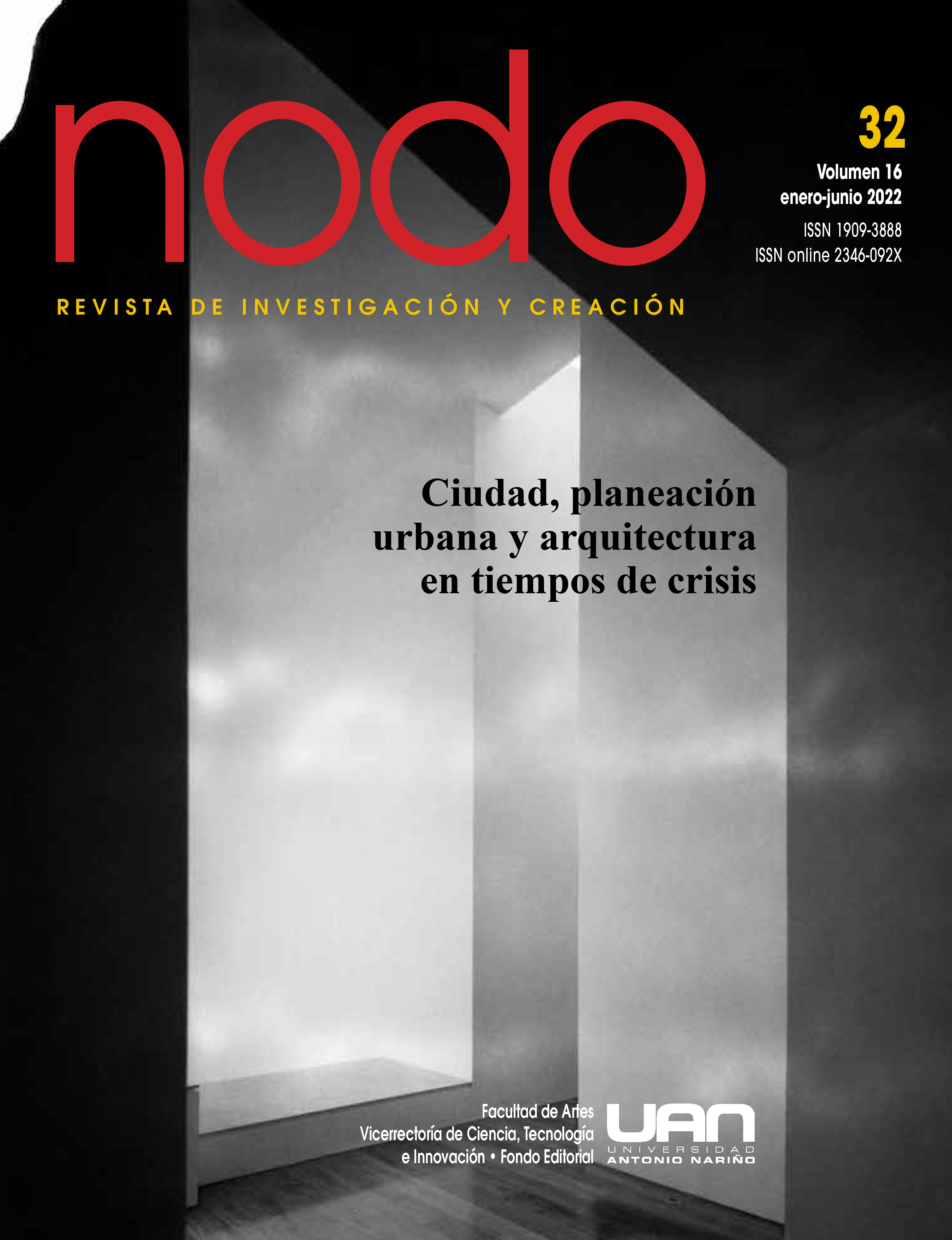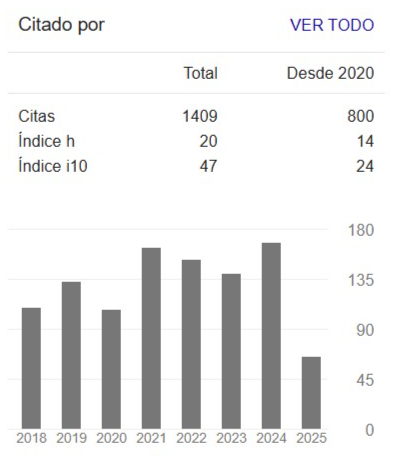Los espacios educativos y su relación comunitaria en Quebrada Verde Pachacamac, Lima, Perú: un análisis sobre la calidad
DOI:
https://doi.org/10.54104/nodo.v16n32.1353Palabras clave:
arquitectura educacional, aulas, calidad, eficiencia y confort, entornos naturales, espacios educativosResumen
En este artículo se ordenan estándares básicos de calidad en espacios didácticos, desarrollados con base en guías y manuales nacionales e internacionales. Éstos serán de utilidad para desarrollar espacios educativos contemporáneos posibles de relacionarse con el entorno natural cercano al contexto donde se emplazan. En este caso se analiza la situación del colegio Santa María Reyna de Quebrada Verde en Pachacamac, Lima, Perú, en específico, las variables de mobiliario educativo, flexibilidad espacial, materialidad y eficiencia-confort, y su relación con el ecosistema de lomas de lúcumo donde se encuentra ubicado. La metodología utilizada es descriptiva, analítica y correlacional; el instrumento en desarrollo es la guía de observación. Se concluye que los espacios educativos de este centro de estudio no son de calidad, lo que provoca dilación en el progreso de las actividades que llevan a cabo sus usuarios.
Descargas
Citas
Augustinaitė, D. (2018). Challenges of innovative architecture: education and practice. Journal of Architecture and Urbanism, 42 (1), pp. 63-69. https://doi.org/10.3846/jau.2018.1989
Bardí-Milà, B., García-Escudero, D., García, B. A., & Martínez, M. M. (2018). Workshop on educational innovation in architecture: JIDA ’17 fifth edition. Journal of Technology and Science Education, 8 (3), pp. 141-145.
Barzan, F., Gracia, M., & Rosatti, L. (2017). Arquitectura y educación no tradicional (tesis pregrado). Universidad Nacional del Litoral, Argentina.
Bautista, G., & Borges, F. (2013). Smart Classrooms: Innovation in formal learning spaces to transform learning experiences. Bulletin of the IEEE Technical Committee on Learning Technology, 15 (3), pp. 18-21.
Bughio, M., Schuetze, T., & Mahar, W. A. (2020). Comparative Analysis of Indoor Environmental Quality of Architectural Campus Buildings’ Lecture Halls and its’ Perception by Building Users, in Karachi, Pakistan. Sustainability, 12 (7), p. 2995. https://doi.org/10.3390/su12072995
Cáceres, E., Durón, E., & Rasion, B. (2014). Uso del aula de clases como recurso didáctico en el proceso enseñanza-aprendizaje de los estudiantes, de la carrera del profesorado en la enseñanza del español, de la UPNFM (tesis de posgrado). Universidad Pedagógica Nacional Francisco Morazán.
Castillo Hispán, S., & Valero Ramos, E. (2016). La arquitectura escolar de José María García de Paredes en Granada. Un prototipo, tres escuelas. Informes de La Construcción, 68 (541): 38, pp. 1-11. http://dx.doi.org/10.3989/ic.15.133
Castonguay, G., & Jutras, S. (2009). Children’s appreciation of outdoor places in a poor neighborhood. Journal of Environmental Psychology, 29 (1), pp. 101-109. https://doi.org/10.1016/j.jenvp.2008.05.002
Causone, F. (2016). Climatic potential for natural ventilation. Architectural Science Review, 59:3, pp. 212-228. http://10.1080/00038628.2015.1043722
Chan, Y. C., & Tzempelikos, A. (2013). Efficient venetian blind control strategies considering daylight utilization and glare protection. Solar Energy, 98, pp. 241-254. https://doi.org/10.1016/j.solener.2013.10.005
Chimborazo Chimborazo, J. L. (2015). Identificación de riesgos del nivel de iluminación de aulas, talleres y laboratorios de la Facultad de Mecánica-ESPOCH bajo normas vigentes (Bachelor’s thesis), Escuela Superior Politécnica de Chimborazo.
Comité de Entornos Laborales de Nueva Jersey (2014). Hoja informativa para la familia sobre los riesgos escolares: “Unidos por temperaturas agradables”. WEC, New Jersey, 1ª ed.
Crespo, J., &Lorenzo, M. (2016). Los espacios de la escuela primaria inclusiva: conexiones y desarmonías entre la normativa de construcciones escolares y las finalidades del sistema educativo. Bordón. Revista de Pedagogía, 68 (1), pp. 131-144. http://dx.doi.org/10.13042/Bordon.2016.68108
Dadvand, P., Nieuwenhuijsen, M. J., Esnaola, M., Forns, J., Basagaña, X., Alvarez-Pedrerol, M., & Jerrett, M. (2015). Green spaces and cognitive development in primary schoolchildren. Proceedings of the National Academy of Sciences, 112 (26), pp. 7937-7942. https://doi.org/10.1073/pnas.1503402112
Day, C., & Midbjer, A. (2007). Environment and children. Routledge. Oxford, Architectural Press.
Durán-Narucki, V. (2008). School building condition, school attendance, and academic achievement in New York City public schools: A mediation model. Journal of Environmental Psychology, 28 (3), pp. 278-286. https://doi.org/10.1016/j.jenvp.2008.02.008
Flecha, L. G. R., & Chaves, V. E. J. (2019). Determination of indicators and verification sources necessary for the Physical Infrastructure of Higher Education Educational Projects in Paraguay. Revista de la Sociedad Científica del Paraguay, 24 (2), pp. 321-348. https://doi.org/10.32480/rscp.2019-24-2.321-348
García, E. T. A. (2017). La ciudad como espacio habitado y fuente de socialización. Ánfora, 24 (42), pp. 189-216. https://doi.org/10.30854/anf.v24.n42.2017.170
Gareca M. (2016). Impacto de la calidad de las aulas del nivel secundario en el proceso de enseñanza aprendizaje. Revista Ciencia, Tecnología e Innovación, 13 (14), pp. 771-782.
INIFED (2014). “Normas y especificaciones para estudios, proyectos, construcción e instalaciones”. Secretaría de Educación Pública de México. Vol. 3: Habitabilidad y funcionamiento.
Lizarazo, D. C. B., González, C. J. S., & Correal, F. E. (2015). Mobiliario escolar: el reto de la pedagogía al diseño. Iconofacto, 11 (16), pp. 141-152.
Ma’bdeh, S. N., Al-Zghoul, A., Alradaideh, T., Bataineh, A., & Ahmad, S. (2020). Simulation study for natural ventilation retrofitting techniques in educational classrooms. A case study. Heliyon, 6 (10), e05171. https://doi.org/10.1016/j.heliyon.2020.e05171
Marín Bedoya, H. D. (2012). Infraestructura física, relacionada con la calidad en la educación en las instituciones oficiales de la comuna 1 del Municipio de Bello (tesis de maestría, especialización en alta gerencia). Universidad de Medellín, Colombia.
Michael, A. (2012). Educational architecture: evaluation and proposals for energy performance of the building envelope. J. Renew. Energy Power Qual., 10 (265). https://doi.org/10.24084/repqj10.265
Ministerio de Educación del Gobierno de Chile (2016). Criterios de diseño para los nuevos espacios educativos, Santiago, Chile.
Ministerio de Educación del Perú (2015). Guía de diseño de espacios educativos-acondicionamiento de locales escolares al nuevo modelo de educación básica regular. Primaria y secundaria. MINEDU: Lima, pp. 1-296.
Ministerio de Educación del Perú (2017). Plan Nacional de Infraestructura Educativa al 2025. Lima.
Moazzeni, M.H. & Ghiabaklou, Z. (2016). Investigating the Influence of Light Shelf Geometry Parameters on Daylight Performance and Visual Comfort. A Case Study of Educational Space in Tehran, Iran. Buildings, 6, p. 26. https://doi.org/10. 3390/buildings6030026
Montiel, I., Mayoral, A. M., Navarro Pedreño, J., Maiques, S., & Marco Dos Santos, G. (2020). Linking Sustainable Development Goals with Thermal Comfort and Lighting Conditions in Educational Environments. Education Sciences, 10 (3), p. 65. https://doi.org/10.3390/educsci10030065
Omar, O., García-Fernández, B., Fernández-Balbuena, A. Á., & Vázquez-Moliní, D. (2018). Optimization of daylight utilization in energy saving application on the library in faculty of architecture, design and built environment, Beirut Arab, University. Alexandria Engineering Journal, 57 (4), pp. 3921-3930. https://doi.org/10.1016/j.aej.2018.10.006
Pía Fontana, M., & Mayorga Cárdenas, M. (2017). ¿Pueden los patios escolares hacer ciudad? Proyecto, Progreso, Arquitectura, 17, pp. 116-131.
Quesada-Chaves, M. J. (2019). Condiciones de la infraestructura educativa en la región pacífico central: los espacios escolares que promueven el aprendizaje en las aulas. Revista Educación, 43 (1), pp. 293-311. http://dx.doi.org/10.15517/revedu.v43i1. 28179
Riera, M. (2005). El espacio-ambiente en las escuelas de Reggio Emilia. Indivisa. Boletín de estudio e investigación, Monografía III, pp. 27-36.
Secchi, S., Sciurpi, F., Pierangioli, L., & Randazzo, M. (2015). Retrofit strategies for the improvement of visual comfort and energy performance of classrooms with large windows exposed to East. Energy Procedia, 78, pp. 3144-3149. https://doi.org/10.1016/j.egypro.2015.11.771
Sevilla, K., Sanabria, J., & Shedden, M. (2010). Compendio de normas y recomendaciones para la construcción de edificios para la educación (DIEE-MEP). Costa Rica: Ministerio de Educación Pública, Dirección de Infraestructura y Equipamiento Educativo.
Chithra, V. S., & Shiva, S. N. (2018). A review of scientific evidence on indoor air of school building: Pollutants, sources, health effects and management. Asian Journal of Atmospheric Environment (AJAE), 12(2), pp. 87-108. https://doi.org/10. 5572/ajae.2018.12.2.87
Tan, Z. & Deng, X. (2017). Assessment of Natural Ventilation Potential for Residential Buildings across Different Climate Zones in Australia. Atmosphere. 8 (9), p. 177. https://doi.org/10. 3390/atmos8090177
UNESCO (1999). “Guía de diseño de espacios educativos: Proyecto conjunto del Ministerio de Educación con Unesco-Orealc”. Reforma educativa chilena: optimización de la inversión en infraestructura educativa. UNESCO: Santiago, Chile.
Upitis, R. (2007). Four strong schools: Developing a sense of place through school architecture. International Journal of Education and the Arts, 8, pp. 1-16.
Veloso, L., Duarte, A. & Marques, J. (2014). Changing education through learning spaces: impacts of the Portuguese school buildings’ renovation program. Cambridge Journal of Education, 44 (3). https://doi.org/10.1080/0305764X.2014.921280
Wilhelm, D. (2018). Guía para la selección de terrenos para construir infraestructura social. Banco Interamericano de Desarrollo, Sector Social. (III). Título. IV.
Zanin, N. & González de Castells, A. (2020). Intervenção de arquitetura para uma escola Guarani: processo de projeto e apropriação de ambientes educativos na Tekoa Itaty, SC. Interações (Campo Grande), 21(3), 439-460. https://doi.org/10.20435/inter.v21i3.2074
Descargas
Publicado
Versiones
- 2022-05-17 (2)
- 2022-05-13 (1)
-
Resumen1522
-
PDF813
Cómo citar
Número
Sección
Licencia
Derechos de autor 2022 Universidad Antonio Nariño

Esta obra está bajo una licencia internacional Creative Commons Atribución-SinDerivadas 4.0.




 Portal de Ciencia Abierta
Portal de Ciencia Abierta